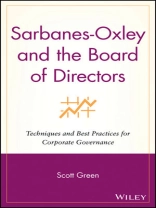Sarbanes-Oxley and the Board of Directors is a practical, down-to-earth guide for board members. It covers everything from board basics to compliance with regulations, corporate culture and values to assessing and reacting to hostile shareholder activities. Complete with real-world examples, vignettes, case studies, and other information, this guide helps board members, CEOs, CFOs, and others understand their responsibilities and potential liabilities and implement effective corporate governance. It covers building a strong framework for effective governance, ways to protect board members, specific guidance for effective corporate oversight and communications, and more. Sarbanes-Oxley and the Board of Directors gives directors the knowledge, techniques, and tools to serve the company and its stockholders well.
Inhaltsverzeichnis
Preface.
Acknowledgments.
Chapter 1: A Sturdy Framework.
PART I: GOVERNANCE FACTOR I.
Building a Strong Foundation.
Chapter 2: Making of a Governance Revolution.
Regulatory Development in the United States.
Relative Maturity of Worldwide Governance.
Chapter 3: Board Basics.
Independence Is the Key.
Board Size Matters.
Committees: Source of Functional Support.
The Imperial CEO.
Director Development.
Chapter 4: Dealing with Your Liability Up Front.
Business Judgment ‚Bunker‘.
Next Line of Defense: Indemnity and Insurance.
Reputation: A Priceless Asset.
PART II: GOVERNANCE FACTOR II.
Organize to Lead.
Chapter 5: Minding the Numbers: The Audit Committee.
A Strong Constitution: The Audit Committee Charter.
Your Financial Experts.
Listen to the Whiners.
Managing the Auditors.
Red Flags of Financial Reporting.
Internal Control: Six Smart Precertification Steps.
Chapter 6: How Much Is Fair?: The Compensation Committee.
Designing the Plan.
Unspoken Cost: Stock Options.
Piecework: Transaction Compensation.
Danger of Oversized Parachutes.
Measuring Performance.
Unwanted Incentives.
Tell Us about Your Shareholder Equity Plan.
The Fight Is On!
Chapter 7: Keeping It Clean: The Corporate Governance/Nominating Committee.
Governing the Board.
Setting the Rules.
Evaluating the Board.
And the Directors.
And the CEO.
Next! Succession Planning.
Finding That Perfect Director.
Is the Strategy Still Valid?
Chapter 8: Other Committees to Have and to Avoid.
Where Have All of the Executive Committees Gone?
Reemergence of Finance Committees.
When Public Policy, Safety, and Research Are Drivers.
Addressing Special Occasions.
PART III: GOVERNANCE FACTOR III.
Insist on High Standards.
Chapter 9: Hard Work of Building Corporate Values.
What We Stand For: Statement of Corporate Values.
Establishing Behavioral Boundaries.
Reporting Bad Behaviors.
Rewarding the Good.
Learning to Communicate Openly.
Chapter 10: Healthy Board Dynamics.
Deciding Who We Are and How We Will Operate.
Coveted Culture.
Wanting to Be Engaged.
Informed and Proud of It.
In the Spirit of Independence.
Talking Frankly: Executive Sessions.
Balance the Board.
Insist on the Best and the Brightest.
Final Decision.
PART IV: GOVERNANCE FACTOR IV.
Let Them Know You Are Watching.
Chapter 11: Art of Oversight.
Business Perspective: Monitoring Operations.
Risk Perspective: Monitoring Threats and Dangers.
Compliance Perspective: Monitoring Management.
Chapter 12: Hostile Activities.
Repelling Sharks.
Staggering Boards.
Ingesting Poison Pills.
Voting Confidentially.
Antishareholder Provisions.
PART V: GOVERNANCE FACTOR V.
Communicating Clearly.
Chapter 13: Speaking to the Crowd.
Importance of Managing Integrity.
Disclosing Operating Weakness.
Responding to Regulatory Scrutiny.
Shareholder Activists: The Emerging Marker.
What Not to Do.
Damage Control.
Chapter 14: Required Communications.
Perfecting Event Reporting.
Other New Reporting Requirements.
OTHER USEFUL ADVICE AND CONCLUSIONS.
Chapter 15: Big Money, Little Money, No Money.
The Moneymakers.
Not-for-Profit Boards.
Serving on Advisory Boards.
A Word about Small Public Companies.
Chapter 16: A Call to Service.
Appendix A: GMI Corporate Governance Ratings.
Appendix B: General Motors Corporation: Audit Committee of the Board of Directors Charter.
Appendix C: Board Evaluation Tool: NACD Sample Board Self-Assessment Questionnaire.
Appendix D: Champion Enterprises, Inc. CEO Evaluation.
Appendix E: Statement of Values: Johnson & Johnson Credo.
Appendix F: TIAA-CREF Principles for Fund Governance and Practices.
Index.
Über den Autor
SCOTT GREEN, CPA, is the Compliance Director for Weil, Gotshal and Manges (one of the largest law firms in the world), and has nearly twenty years of experience in the related fields of corporate governance, management controls, finance, and accounting. He is a graduate of the University of Idaho and Harvard Business School. A sought-after speaker and expert on Sarbanes-Oxley, Green has written numerous articles published in professional journals. He authored Manager’s Guide to the Sarbanes-Oxley Act: Improving Internal Controls to Prevent Fraud, also published by Wiley.












